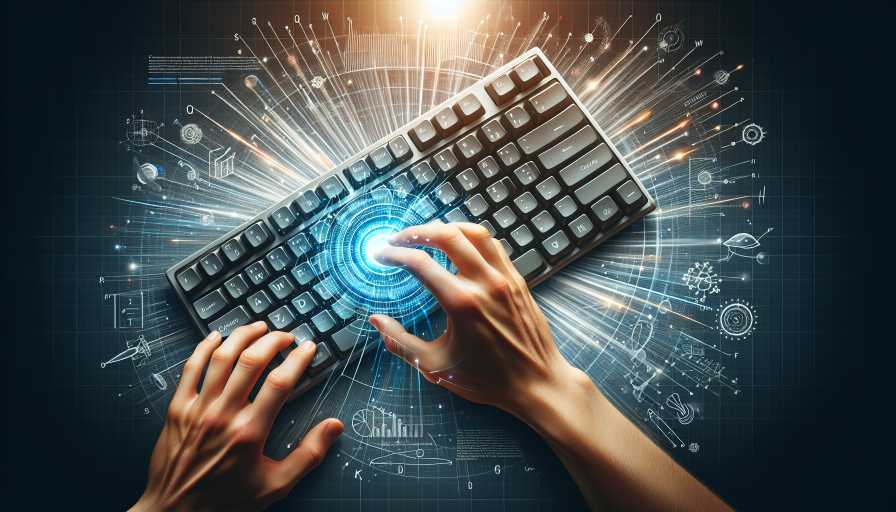# The Science behind Typing Speed and Accuracy
Have you ever wondered what separates an average typist from a lightning-fast one? Or why some people are able to type accurately with minimal errors while others struggle to hit the right keys? The answer lies in the fascinating science behind typing speed and accuracy. In this blog post, we will delve into the secrets of what makes a typist truly exceptional.
# The Keyboard Connection
Before we delve into the nitty-gritty, let's start with the basics - the keyboard. Keyboard hardware plays a crucial role in determining typing speed and accuracy. The design, layout, and ergonomics of the keyboard can significantly impact your performance.
When selecting a keyboard, it's important to consider factors such as key spacing, key travel distance, and tactile feedback. These features can make a world of difference in your typing experience. For instance, keyboards with mechanical switches are often preferred by fast typists due to their tactile feedback and precise key actuation.
# The Power of Muscle Memory
When you watch an expert typist in action, you'll notice something incredible - their fingers dance across the keyboard with seemingly effortless precision. This is all thanks to muscle memory.
Muscle memory is the ability of our muscles to perform certain tasks without conscious effort. With consistent practice, our fingers become familiar with the keyboard layout, allowing us to type more quickly and accurately.
If you want to improve your typing speed and accuracy, the key is practice. Typing tests and exercises that focus on specific key combinations can help train your muscles to remember the positions of the keys. By dedicating just a few minutes each day to practice, you'll start seeing significant improvements in no time.
# The Impact of External Factors
While keyboard hardware and muscle memory play vital roles in typing speed and accuracy, external factors can also influence your performance. Let's take a look at some of these factors:
# 1. Posture and Ergonomics
Believe it or not, your posture affects your typing performance. Sitting in a slouched position for extended periods can strain your muscles and lead to fatigue. Maintaining an ergonomic posture, with your back straight and wrists slightly elevated, can help prevent discomfort and improve efficiency.
# 2. Distractions
Typing requires focus and concentration. Distractions such as noise, notifications, and cluttered workspaces can hinder your typing speed and accuracy. Creating a quiet and organized environment can significantly enhance your productivity.
# 3. Stress Levels
Stress and anxiety can negatively impact your typing abilities. When we are stressed, our muscle tension increases, leading to decreased accuracy and speed. Finding ways to manage stress, such as deep breathing exercises or taking short breaks, can help you maintain optimal performance.
# The Numbers Game
For the data geeks out there, typing speed and accuracy can be a treasure trove of captivating statistics. Here are a few intriguing figures:
- The average typing speed for English speakers is around 40 words per minute (WPM).
- Professional typists can reach speeds of 75 WPM or higher, with accuracy rates above 95%.
- The fastest typist in the world, Barbara Blackburn, achieved a staggering speed of 212 WPM.
These numbers go to show that with practice and dedication, anyone can improve their typing speed and accuracy.
# Life Hacks and Optimization Tips
Now that we've covered the science behind typing speed and accuracy, let's explore some practical life hacks and optimization tips to help you become a typing wizard:
- Use online typing tests: Typing tests provide a structured and timed environment to practice your skills. Websites like TypeTest.io offer a wide range of tests and measurements to help track your progress.
- Master keyboard shortcuts: Learning keyboard shortcuts for common actions can save you a tremendous amount of time and effort.
- Elevate your typing technique: Proper finger placement and touch typing techniques can significantly enhance speed and accuracy. Consider taking a typing course or online tutorial to improve your technique.
- Practice regularly: Consistency is key. Make typing practice a part of your daily routine, and you'll witness significant improvements over time.
# Conclusion
As you can see, the science behind typing speed and accuracy is a captivating field filled with intriguing facts and optimization strategies. By understanding the impact of factors such as keyboard hardware, muscle memory, external influences, and embracing life hacks, you can unlock the true potential of your typing abilities.
So, why wait? Start practicing, optimize your typing setup, and watch as your speed and accuracy soar to new heights. Happy typing!
